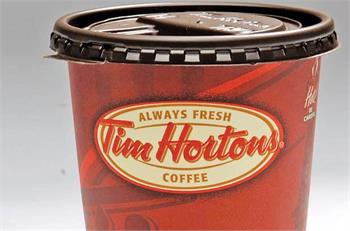 |
Tim Hortons vs the world: Canadian coffee wars
 |
On the ice, Tim Horton was known to dole out “Horton hugs,” squeezing his rivals until they couldn’t breathe.
Now, 50 years after Horton opened his first coffee shop, Tim Hortons Inc. execs will need to channel its founder’s defensive style as it prepares to hit back in an increasingly crowded market.
Although Tim Hortons still dominates the Canadian coffee market, holding just over 75 per cent of it with about 3,500 outlets in Canada, the company recently missed analysts’ profit expectations for 2013. Tim’s is unveiling its plan to squeeze key players like McDonald’s McCafé and Starbucks, which have dropped the gloves in the fight for java supremacy.
When Tim’s opened its first store in Hamilton in May 1964, it had the arena to itself, said Douglas Hunter, who has written books on both Horton and Hortons.
“Tim’s could expand easily, move right next to McDonald’s and it didn’t matter, they were selling different products.”
It matters now.
Enter Mickey D’s
McDonald’s Restaurants of Canada Ltd. is aggressively going after longtime Tim’s fans.
In 2007, the burger giant jolted its competitors by winning a Consumer Reports taste test. When the Golden Arches launched McCafé in Canada in 2009, it gave away its coffee for free. McD’s aggressive game has reaped rewards: it has doubled its market share here to about 10 per cent in under five years.
This week customers can get a free coffee in a sleek brown-and-white cup at one of McDonald’s almost 1,500 outposts in Canada. But free java will not sway Yasha Grey, a 25-year-old master’s student in St. Catharines,
Ont., who usually orders a single-single (one cream, one sugar), coming in a Tim’s iconic red-and-yellow Roll Up the Rim to Win cup these days.
“It may sound cheesy, but I really like that Tim Hortons is Canadian,” Grey said. “I like its homey, country feel.”
Cheesy or not, serving up a side of Canadiana works.
Starbucks ups the ante
The power of patriotism is now percolating over at Starbucks Canada. The world java juggernaut first came to Canada in 1987 with a single outlet in Vancouver. It now has more than 1,000 outlets here and will open about 100 more this year. Its baristas now pour a Canada-only brew named True North into minimalist green-and-white cups. And, as we enter maple-syrup season, Starbucks is unveiling the Maple Macchiato next week.
Canadian chains suffer
While Timothy’s Coffees of the World Inc. and The Second Cup Ltd. opened their doors in Canada 12 years before Starbucks, they have not been able to maintain their head start.
Timothy’s grew from one store in London to about 139 in 2009. It is down to about 100 stores after its wholesale and retail businesses were spun off and sold to U.S. companies.
Second Cup started as a kiosk in a Toronto mall and now has about 350 cafés. It dropped its CEO late last year after it posted a loss of $8.5 million. But the chain is mounting a comeback under Alix Box, who once worked as an executive at Starbucks and officially took the reins Monday.
Changing tastes
Unlike its smaller Canadian compatriots, Tim’s has been able to stay ahead of international competitors so far.
But to some, the chain is starting to taste stale and needs to brew up a fresh pot of business fast.
“We are moving into a different era. The baby boomers Tim’s has relied on are getting older,” said Douglas Stephens, a leading retail analyst based in Toronto.
In a bid to attract baby boomers’ kids and grandkids, all coffee sellers must hatch bold strategies.
We love coffee, with a whopping 65 per cent of us drinking it daily, according to a study by the Coffee Association of Canada, but changing demographics mean changing tastes.
Millennials demand that products be healthy and ethically sourced. Oh, and also cheap. And many new Canadians don’t even drink coffee, opting for tea instead, noted Stephens.
Like the real Horton, Tim Hortons’ top brass will have to mount a strong defence if the chain is to remain the top player in the good ol’ coffee game.
The coffee pot has gone to pod
“In the at-home category, single-serve machines have been a category disruptive phenomenon,” said Sandy McAlpine, head of the Coffee Association of Canada.
Keurig, Tassimo and Nespresso currently dominate the market, said McAlpine.
The focus of Tim Hortons, McDonald’s and Starbucks is take-out brew, but the at-home market can’t be ignored.
Just over half of Canadians make their cuppa at home daily, while only 24 per cent buy takeout every day, noted McAlpine.
In response, Tim’s announced last week it will expand its Keurig K-discs and Tassimo T-discs to grocery-store shelves later this year. McD’s, under its McCafé brand, has teamed up with Kraft and will test selling pods in
U.S. grocery stores soon. Starbucks opted to launch its own machine and pods, called Verismo, in its Canadian stores in late 2012.
Pods have certainly perked up the home market, and the takeout coffee champs have all set their sights on adding some at-home fans to their base.
1137 page views
|
|
|
|